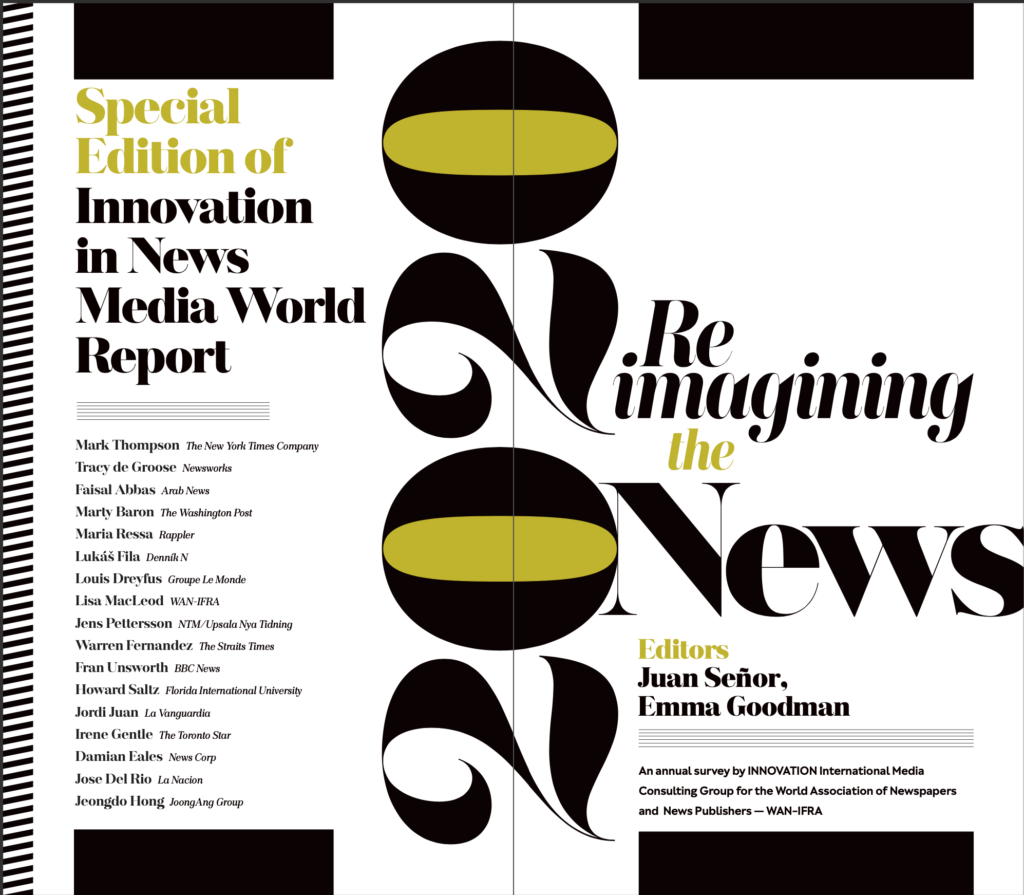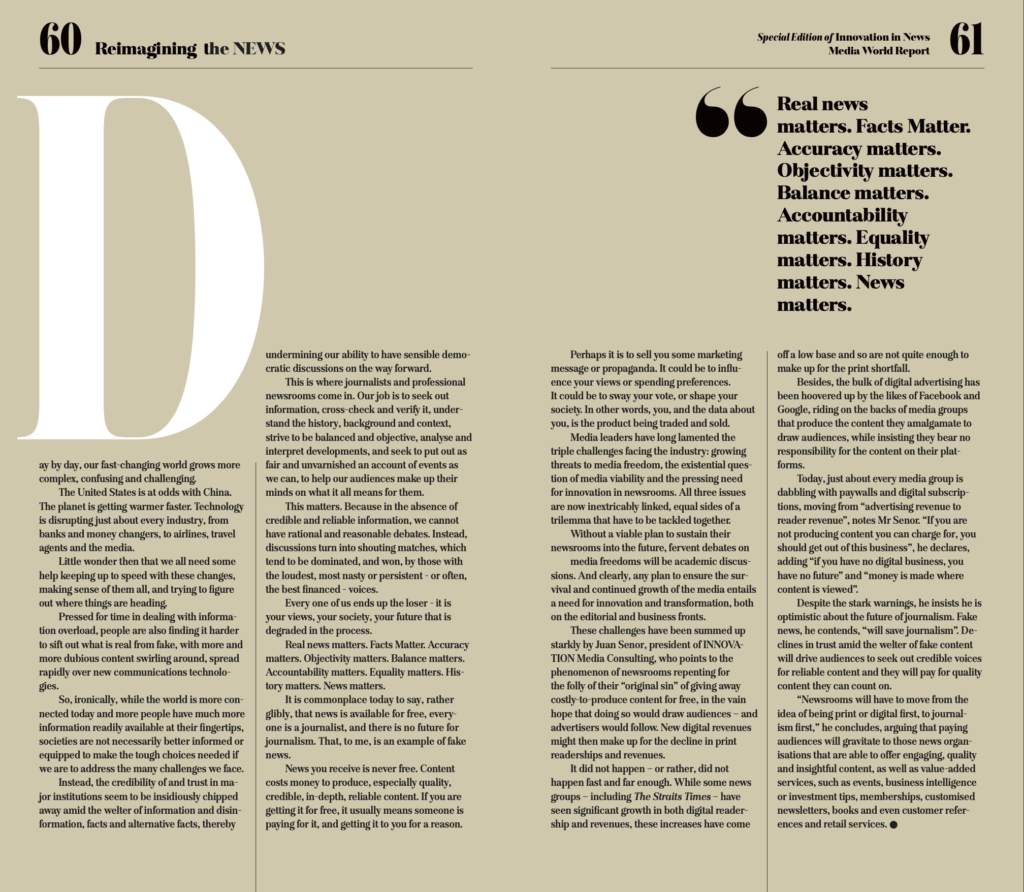
30 Aug Real News Matters
By Warren Fernandez
Editor in Chief,
The Straits Times
Day by day, our fast-changing world grows more complex, confusing and challenging.
The United States is at odds with China. The planet is getting warmer faster. Technology is disrupting just about every industry, from banks and money changers, to airlines, travel agents and the media.
Little wonder then that we all need some help keeping up to speed with these changes, making sense of them all, and trying to figure out where things are heading.
Pressed for time in dealing with information overload, people are also finding it harder to sift out what is real from fake, with more and more dubious content swirling around, spread rapidly over new communications technologies.
So, ironically, while the world is more connected today and more people have much more information readily available at their fingertips, societies are not necessarily better informed or equipped to make the tough choices needed if we are to address the many challenges we face.
Instead, the credibility of and trust in major institutions seem to be insidiously chipped away amid the welter of information and disin- formation, facts and alternative facts, thereby undermining our ability to have sensible demo- cratic discussions on the way forward.
This is where journalists and professional newsrooms come in. Our job is to seek out information, cross-check and verify it, understand the history, background and context, strive to be balanced and objective, analyse and interpret developments, and seek to put out as fair and unvarnished an account of events as we can, to help our audiences make up their minds on what it all means for them.

This matters. Because in the absence of credible and reliable information, we cannot have rational and reasonable debates. Instead, discussions turn into shouting matches, which tend to be dominated, and won, by those with the loudest, most nasty or persistent – or often, the best financed voices.
Every one of us ends up the loser – it is your views, your society, your future that is degraded in the process.
Real news matters. Facts Matter. Accuracy matters. Objectivity matters. Balance matters. Accountability matters. Equality matters. History matters. News matters.
It is commonplace today to say, rather glibly, that news is available for free, everyone is a journalist, and there is no future for journalism. That, to me, is an example of fake news.
News you receive is never free. Content costs money to produce, especially quality, credible, in-depth, reliable content. If you are getting it for free, it usually means someone is paying for it, and getting it to you for a reason.
“Real news matters. Facts Matter. Accuracy matters. Objectivity matters. Balance matters. Accountability matters. Equality matters. History matters. News matters.“
Perhaps it is to sell you some marketing message or propaganda. It could be to influence your views or spending preferences.
It could be to sway your vote, or shape your society. In other words, you, and the data about you, is the product being traded and sold.
Media leaders have long lamented the triple challenges facing the industry: growing threats to media freedom, the existential question of media viability and the pressing need for innovation in newsrooms. All three issues are now inextricably linked, equal sides of a trilemma that have to be tackled together.
Without a viable plan to sustain their newsrooms into the future, fervent debates on media freedoms will be academic discussions. And clearly, any plan to ensure the survival and continued growth of the media entails a need for innovation and transformation, both on the editorial and business fronts.
These challenges have been summed up starkly by Juan Senor, president of INNOVATION Media Consulting, who points to the phenomenon of newsrooms repenting for the folly of their “original sin” of giving away costly-to-produce content for free, in the vain hope that doing so would draw audiences – and advertisers would follow. New digital revenues might then make up for the decline in print readerships and revenues.
It did not happen – or rather, did not happen fast and far enough. While some news groups – including The Straits Times – have seen significant growth in both digital reader- ship and revenues, these increases have come off a low base and so are not quite enough to make up for the print shortfall.

Besides, the bulk of digital advertising has been hoovered up by the likes of Facebook and Google, riding on the backs of media groups that produce the content they amalgamate to draw audiences, while insisting they bear no responsibility for the content on their platforms.
Today, just about every media group is dabbling with paywalls and digital subscriptions, moving from “advertising revenue to reader revenue”, notes Mr Senor. “If you are not producing content you can charge for, you should get out of this business”, he declares, adding “if you have no digital business, you have no future” and “money is made where content is viewed”.
Despite the stark warnings, he insists he is optimistic about the future of journalism. Fake news, he contends, “will save journalism”. Declines in trust amid the welter of fake content will drive audiences to seek out credible voices for reliable content and they will pay for quality content they can count on.
“Newsrooms will have to move from the idea of being print or digital first, to journalism first,” he concludes, arguing that paying audiences will gravitate to those news organisations that are able to offer engaging, quality and insightful content, as well as value-added services, such as events, business intelligence or investment tips, memberships, customised newsletters, books and even customer references and retail services. ●


